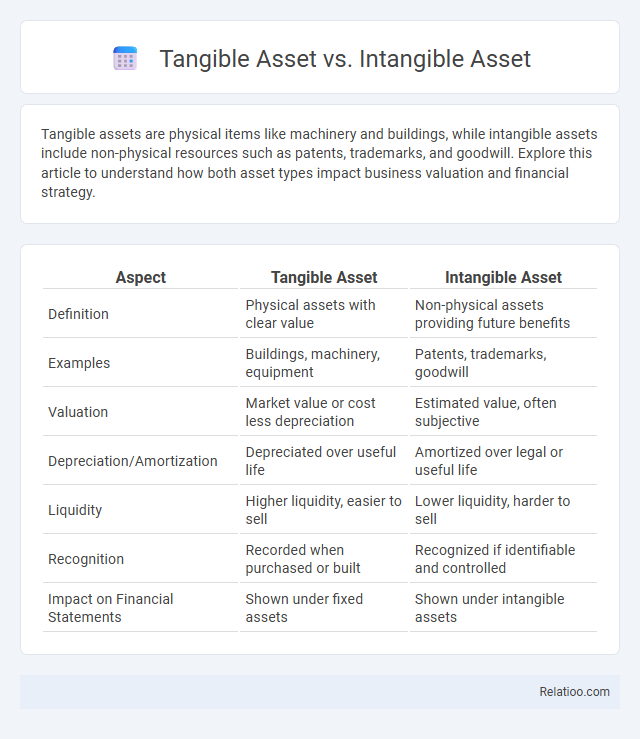Tangible assets are physical items like machinery and buildings, while intangible assets include non-physical resources such as patents, trademarks, and goodwill. Explore this article to understand how both asset types impact business valuation and financial strategy.
Table of Comparison
| Aspect | Tangible Asset | Intangible Asset |
|---|---|---|
| Definition | Physical assets with clear value | Non-physical assets providing future benefits |
| Examples | Buildings, machinery, equipment | Patents, trademarks, goodwill |
| Valuation | Market value or cost less depreciation | Estimated value, often subjective |
| Depreciation/Amortization | Depreciated over useful life | Amortized over legal or useful life |
| Liquidity | Higher liquidity, easier to sell | Lower liquidity, harder to sell |
| Recognition | Recorded when purchased or built | Recognized if identifiable and controlled |
| Impact on Financial Statements | Shown under fixed assets | Shown under intangible assets |
Definition of Tangible and Intangible Assets
Tangible assets are physical items such as machinery, buildings, and inventory that hold value and can be touched or seen. Intangible assets, on the other hand, are non-physical resources like patents, trademarks, and goodwill that provide long-term value but lack a physical presence. Understanding the distinction helps you manage your assets more effectively by categorizing and leveraging both tangible and intangible resources in your financial planning.
Key Differences Between Tangible and Intangible Assets
Tangible assets are physical items like machinery, buildings, or inventory that you can touch and see, while intangible assets include non-physical resources such as patents, trademarks, and goodwill. The key differences lie in their physical presence, valuation methods, and depreciation--tangible assets can be depreciated over time, whereas intangible assets are amortized or evaluated based on legal protections and market value. Understanding these distinctions is crucial for accurate financial reporting and asset management in your business.
Examples of Tangible Assets
Tangible assets include physical items such as machinery, buildings, vehicles, and inventory that a company uses for operations or capital investment. Unlike intangible assets like patents, trademarks, or goodwill, tangible assets have a clear physical presence and can be appraised or depreciated over time. Asset classification impacts financial reporting, tax treatment, and valuation, making tangible asset examples essential for accurate business accounting.
Examples of Intangible Assets
Intangible assets include non-physical resources such as patents, trademarks, copyrights, brand reputation, and goodwill, which provide long-term value and competitive advantage to businesses. Tangible assets, by contrast, are physical items like machinery, buildings, land, and inventory that have measurable physical substance. Understanding the distinction between intangible and tangible assets helps companies effectively manage their overall asset portfolio for accurate financial reporting and strategic growth.
Valuation Methods for Tangible and Intangible Assets
Valuation methods for tangible assets typically involve market value, cost, or income approaches, emphasizing physical characteristics and replacement costs. Intangible asset valuation relies on income-based methods such as discounted cash flow (DCF), relief-from-royalty, or cost to recreate, focusing on future economic benefits and intellectual property value. Your choice between these methods depends on the nature of the asset and its role in financial reporting or investment analysis.
Importance of Tangible and Intangible Assets in Business
Tangible assets, such as machinery, buildings, and inventory, provide businesses with physical resources essential for daily operations and production. Intangible assets, including patents, trademarks, and goodwill, offer competitive advantages by enhancing brand value, innovation potential, and customer loyalty. Both tangible and intangible assets are critical for a company's overall valuation, operational efficiency, and long-term strategic growth.
Accounting Treatment for Tangible vs Intangible Assets
Tangible assets, such as machinery and buildings, are depreciated over their useful lives using methods like straight-line or declining balance to systematically allocate cost. Intangible assets, including patents and trademarks, are amortized if they have finite useful lives or tested annually for impairment if indefinite. Your accounting must differentiate these treatments as tangible assets involve physical depreciation while intangible assets require amortization or impairment reviews for accurate financial reporting.
Impact on Financial Statements
Tangible assets, such as machinery and buildings, appear on the balance sheet as physical property and are subject to depreciation expense that reduces net income over time. Intangible assets, including patents and trademarks, are recorded at acquisition cost and amortized systematically, influencing both asset value and profit margins. Overall, assets encompass both types, impacting financial statements through valuation, amortization or depreciation schedules, and their roles in liquidity and solvency metrics.
Advantages and Disadvantages of Each Asset Type
Tangible assets such as machinery and buildings provide physical presence and collateral value but can depreciate and require maintenance, limiting liquidity. Intangible assets like patents and trademarks offer competitive advantages and potential for revenue growth without physical wear, though they face challenges in valuation and may have limited legal protection. General assets encompass both types, balancing the benefits of physical reliability and innovation-driven growth while presenting complexities in accounting and risk management.
Strategic Management of Tangible and Intangible Assets
Tangible assets, such as machinery and real estate, provide physical resources crucial for operational efficiency, while intangible assets like patents and brand reputation drive competitive advantage through innovation and customer loyalty. Strategic management of these assets requires balancing investment in physical infrastructure with cultivating intellectual property and organizational culture to maximize long-term value. Your ability to integrate both tangible and intangible assets effectively influences overall business growth and sustainability.

Infographic: Tangible Asset vs Intangible Asset
 relatioo.com
relatioo.com